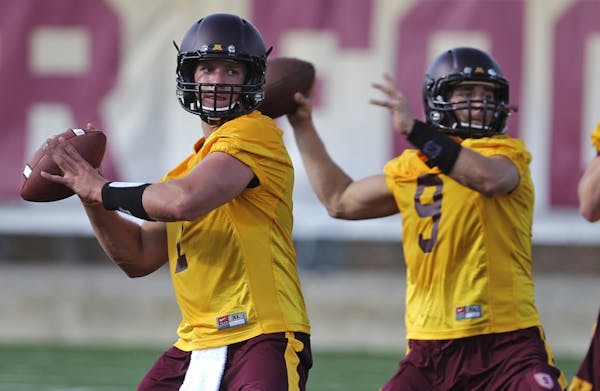When a seizure forced Gophers football coach Jerry Kill to be absent during the second half of last week's game against Western Illinois, how much did he really miss?
Perhaps not as much as some football fans might think, according to those who know exactly what a head coach typically does during a game.
Most decisions the Gophers made after halftime were ones Kill and many head coaches delegate to assistants. Players typically have more interaction with position coaches than Kill during games.
"You don't want to minimize his role in the whole scheme of things," Gophers offensive coordinator Matt Limegrover said. "But I think because we've all been with him so long, we really kind of think on the same page."
With Kill set to return to the sideline for Saturday's game against San Jose State, his situation is distinctive. Most of his assistants have served under him for at least 13 years, and he leans on them heavily.
Some head coaches — including Penn State's Bill O'Brien, Florida State's Jimbo Fisher and USC's Lane Kiffin — call their own offensive plays. Others, such as Alabama's Nick Saban, Florida's Will Muschamp and Northwestern's Pat Fitzgerald, are more hands-on with their defense.
But many coaches are like Kill, relying on coordinators to run most of a game and soliciting input before making key decisions, such as when to call timeout, attempt an onside kick or go for it on fourth down.
"I didn't call any offensive plays and didn't call defensive plays, but I knew what was being called," said former Gophers coach Glen Mason, now an analyst with the Big Ten Network. "I always thought my role was to manage the game, so all the major decisions that took place, I made.
"You didn't micromanage, but you might all of a sudden say, 'Hey, play coverage here, or blitz here' — that type of thing. My offensive staff did a good job calling the plays. Ninety percent of the time, I'd say, 'Hey fine, let's go with it.' "
Inside the headsets
Last week's game against Western Illinois included 66 second-half plays, counting kickoffs and punts, and to hear the Gophers tell it, Kill essentially missed out on one big decision.
It came on Minnesota's first third-quarter possession, with the Gophers clinging to a 7-6 lead. After an 11-yard gain on third down, the Gophers faced fourth-and-2 at the Leathernecks 42-yard line. Go for it or punt?
Had Kill been on the sideline, he would have been on the headset with Limegrover, telling him to get a fourth-down play ready. Then Kill would have clicked over to defensive coordinator Tracy Claeys for his input.
Kill, who has epilepsy, had suffered his third in-game seizure in three years at Minnesota, and the coaches are familiar with the protocol. Claeys takes over as acting head coach and remains in the coaching booth with Limegrover. Defensive backs coach Jay Sawvel relays decisions to the officials from the sideline.
"When we got to fourth-and-2, I had my finger on a play," Limegrover said. "I just looked two guys down, and Tracy was looking at me. He said, 'We're going to punt it.'
"I had no complaint. Tracy called down to Coach Sawvel, and we punted it because that's how Coach would have handled it. So it really wasn't that difficult."
The second half included a few other calls Kill would have made, but those were no-brainers. When David Cobb's 2-yard touchdown run gave the Gophers a 13-12 lead with 1:22 left in the third quarter, they went for the two-point conversion, putting them ahead by a field goal at 15-12.
The Gophers had Chris Hawthorne kick extra points following the next two touchdowns, as they pulled away to win 29-12.
'Manager of a team'
Not every game turns into a 17-point victory, of course. The closer the score, the more decisions a head coach needs to make. The game's final two minutes can include a slew of clock-management decisions that set up coaches for plenty of second-guessing.
"I think a head football coach in this day and age, you're a manager of a team," Kill said. "I called offensive plays for a long time [earlier in his career], but you've got so many demands, you've got to trust your people.
"Anybody at any level does most of their coaching during the week. You prepare your game plan, and you adjust during the game.
"But a lot of coaches like to pat themselves on the back. There's not as many adjustments as you think. You're going to go with what you know and what you do."
Gophers players Ra'Shede Hageman, Mitch Leidner and Brock Vereen all said this week that they typically have little one-on-one interaction with Kill during games. Players report to their position coaches after each series, and that's where most of the instruction gets done.
Kill gives the team a pregame pep talk, barks out encouragement at halftime and assembles the team again for a postgame speech. The players missed his presence last week, but they were hardly lost without him.
In fact, the Gophers played better in the second half, after the seizure, than they did in the first half.
None of this, though, suggests Kill plays an insignificant role. He just doesn't normally do as much as one might think during the three hours when everyone is watching.
"He's like a second father to some of us," Vereen said. "He's the best thing that's happened to this program in years."
Tigers hand Twins season-worst 5th straight loss on Wenceel Pérez's walk-off single in 9th
Juan Soto's 3-run homer in 5-run 7th inning lifts Yankees over Rays 5-3
Braves' Travis d'Arnaud hits first 3 HRs of season, including go-ahead slam, in 8-3 win over Rangers

